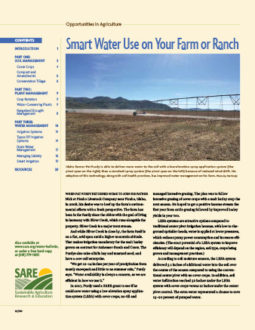As salt accumulates in the soil, crops have more difficulty taking up the water that’s available. High salinity in the root zone also causes nutrient imbalances and affects plant growth and yield. High concentration of specific ions can be toxic to crops.
Salinization occurs when irrigation water evaporates, which leaves salts behind. It is especially prevalent with flood irrigation systems, which tend to over apply water and can raise saline groundwater tables. Once the water table gets close to the surface, capillary water movement transports soil water to the surface, where it evaporates and leaves salts behind. When improperly managed, this can render soils unproductive within a matter of years.
The adverse effect of salinity can be reduced through proper irrigation and crop management practices, such as leaching, selecting plants like barley or alfalfa that can tolerate salinity or specific ions, and soil/water amendments. Testing for salinity and sodicity in irrigation water and soils can help you develop irrigation and crop management practices that will sustain crop yields, maintain or improve soil physical properties, and minimize adverse environmental impacts.
One option is to keep soils moist. Drip irrigation with low-salt water plus a surface mulch does not allow salt content to get as high as it would if allowed to concentrate when the soil dries. Another option is to grow saline-tolerant crops like barley or Bermuda grass.
The only way to get rid of salt is to add sufficient water to wash it below the root zone, which requires significant amounts of water and time. If the subsoil does not drain well, drainage tiles might be needed to get rid of salt water. In arid regions, where shallow groundwater tables and less precipitation is common, irrigation management systems should be designed to both supply and drain water to avoid the issues that contribute to salinity accumulation in soil.
Manage Salinity with Cover Crops
In the Northern Plains, extensive wet periods lead to salinity problems on an estimated 15–35% of cropland. Creating cropping systems that use more water and that drive salts deeper into the soil profile is one recommended strategy for addressing this challenge. Funded by two SARE grants, North Dakota State University Extension specialists partnered with area farmers to demonstrate how crop rotations involving cover crops can manage salinity while providing other soil-health-related benefits.
The team worked with four farmers to implement rotations on salt-affected fields. They were able to extend the amount of time a crop was growing in those fields by up to four months by combining cover crops with an early season, salt-tolerant crop, such as a small grain. Along with better management of excess moisture, these rotations that extended the length of the growing season also improved soil health and developed more sustainable agronomic systems. The cover crops used on each farm were mixes that included cereal rye, radishes and turnips, plus additional species in some treatments.
